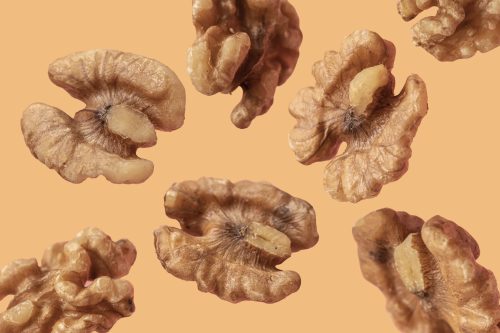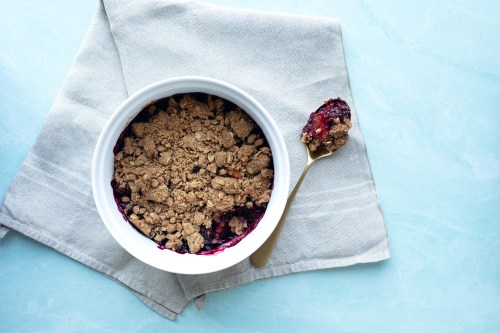advertisement
It’s Time To Enter Your Walnut Era—Because They’re No Longer Just Grandma’s Pantry Staple

When you picture the most aesthetic fridgescapes on Instagram—you know, the ones filled with every wellness food imaginable—what do you see? A packed crisper drawer with fresh produce, for sure. Possibly some Greek yogurt, and a kombucha-adjacent beverage. A variety of meal-prepped grains in glass containers. But do you ever picture a jar of walnuts?
It's time you should. Walnuts deserve real estate in more than just grandma's pantry (and literally every cookie and brownie my own grandma pulled out of the oven). In fact, they deserve a spot in your fridge. Now, as a health-conscious Millennial, I‘m realizing they're way more than a baked-goods go-to—and Lauren Manaker, RDN, registered dietitian nutritionist and California Walnuts partner, agrees.
“Walnuts have long been a staple in baking because of their rich, nutty flavor and satisfying crunch, which add depth and texture to a wide range of sweet treats,” Manaker says. “Their versatility made them a pantry essential in many households, especially in past generations. However, that notion is starting to shift as people are realizing that walnuts are so much more than an addition to baked goods.”
Manaker says she’s recently seen a surge in the popularity of walnuts—especially among the plant-based crowd—as people increasingly look for easy ways to add to their intake of protein, fiber, and good fats. Young people today are thinking about walnuts differently, specifically California walnuts, which have been grown on family farms for generations, bringing a unique combination of heritage, geography, and agricultural expertise. Here are three reasons to add the feel-good staple to your grown-up wellness routine—and, yes, why they're best stored in the fridge.
1. California walnuts offer good-for-you nutrients
The nutritional benefits of California walnuts can’t be overstated. Manaker says walnuts hit the “nutritional trifecta” for helping you feel full and satisfied: protein, fiber, and fats. A one-ounce serving provides four grams of protein, two grams of fiber, and 18 grams of fat, including 2.5 grams of monounsaturated fats and 13 grams of which are polyunsaturated fats (the "good fats").
Walnuts also happen to be the only tree nut that is an excellent source of plant-based omega-3 ALA fatty acids (2.5 grams per ounce), which have been associated with benefits for heart health, brain health, and inflammation, Manaker says.1-3 Plus, they also provide magnesium (10% DV), copper (50% DV), and manganese (40% DV), which support energy production, immune support, and bone health, as well as antioxidants (3.721 mmol/oz), which can help combat oxidative stress.4-7
Last but not least, one of the lesser-known benefits of walnuts is their role in supporting gut health, Manaker says. “Research has shown that a diet enriched with walnuts positively impacts the gut microbiome by enhancing good probiotic- and butyric acid-producing bacteria,” she says. “Butyric acid is thought to be useful for digestive health by helping to maintain the health of the colon.”8
Just think of walnuts as your bite-sized BFFs, helping you live your best life from the inside out.
2. California walnuts are a fresh, natural whole food
Fun fact: You shouldn’t be storing walnuts in your pantry. It’s true—in order to preserve all those feel-good nutrients, walnuts are best enjoyed when stored in the refrigerator because they’re much more temperature-sensitive than other nuts.
“Walnuts contain good fats that can spoil or turn rancid when exposed to warm temperatures for too long,” Manaker says. “Refrigeration helps slow this process by keeping those oils stable, ensuring the nuts stay fresh and tasty for much longer.”
Plus, because California walnuts are grown by multi-generational farming families who take pride in the quality and freshness of the food they grow, you know you’re getting the real deal—sans any weird additives or ultra processing.
3. California walnuts elevate food experiences
If you’ve ever been in a food rut—making the same three meals over and over to the point of taste-bud fatigue—walnuts might be just the thing to get your culinary creativity flowing again.
Of course, California walnuts are delicious as a standalone snack, but Manaker also suggests blending them into sauces to make them creamier, or adding a handful to your morning oatmeal, yogurt, or smoothie for a boost of crunch and nutrition. “You can also try sprinkling them over salads or roasted vegetables for added texture and flavor,” she says. “Or use them crushed instead of breadcrumbs when making breaded fish or chicken.”
Feeling adventurous, or looking for a new Meatless Monday recipe? Try Manaker’s favorite: walnut tacos. Just pulse the walnuts in a food processor until they have a crumbly texture resembling ground meat, and then mix in chili powder, cumin, garlic powder, and a splash of soy sauce or lime juice. Lightly toast the seasoned “walnut meat” in a skillet to bring out its rich flavor and texture, then scoop the mixture into taco shells or lettuce wraps and top with your favorite taco fixings like diced tomatoes, avocado, shredded lettuce, salsa, and a dollop of plain Greek yogurt or sour cream. Grandma could never (but we love her for steering us in the right, nutty direction).
- 1.Fleming JA, Kris-Etherton PM. The evidence for α-linolenic acid and cardiovascular disease benefits: comparisons with eicosapentaenoic acid and docosahexaenoic acid. Adv Nutr. 2014;5(6):863S-76S. doi: 10.3945/an.114.005850
- 2.Barceló-Coblijn G, Murphy EJ. Alpha-linolenic acid and its conversion to longer chain n3 fatty acids: Benefits for human health and a role in maintaining tissue n-3 fatty acid levels. Prog Lipid Res. 2009;48(6):355-74. doi: 10.1016/j.plipres.2009.07.002
- 3.Zhao G, Etherton TD, Martin KR, et al. Dietary Alpha-Linolenic Acid Reduces Inflammatory and Lipid Cardiovascular Risk Factors in Hypercholesterolemic Men and Women. J Nutr. 2004 Nov;134(11):2991-7. doi: 10.1093/jn/134.11.2991.
- 4.National Institutes of Health, Office of Dietary Supplements. (2020, Mar 24). Magnesium Fact Sheet for Health Professionals. https://ods.od.nih.gov/factsheets/Magnesium-HealthProfessional/
- 5.National Institutes of Health, Office of Dietary Supplements. (2020, Feb 27). Copper Fact Sheet for Health Professionals. Retrieved from https://ods.od.nih.gov/factsheets/Copper-HealthProfessional/
- 6.National Institutes of Health, Office of Dietary Supplements. (2020, Feb 14). Manganese Fact Sheet for Health Professionals. Retrieved from https://ods.od.nih.gov/factsheets/Manganese-HealthProfessional/
- 7.Joe A. Vinson, Yuxing Caia. Nuts, Especially Walnuts, Have Both Antioxidant Quantity and Efficacy and Exhibit Significant Potential Health Benefits. Food & Function. 2012,3, 134-140. doi:10.1039/C2FO10152A. The data for antioxidant capacity of foods generated by test-tube methods cannot be extrapolated to human effects. Clinical trials to test benefits of dietary antioxidants have produced mixed results.
- 8.Bamberger C, Rossmeier A, Lechner K, et al. A Walnut-Enriched Diet Affects Gut Microbiome in Healthy Caucasian Subjects: A Randomized, Controlled Trial. Nutrients. 2018;10(2):244. doi:10.3390/nu10020244



